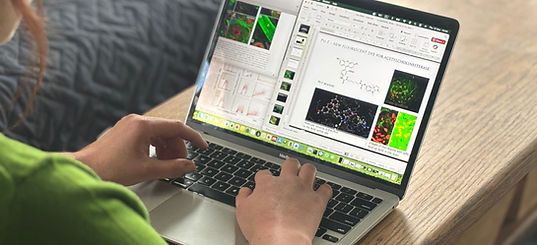About me

Personal skills
Project portfolio
Popular science
I have authored a number of science communication articles on topics such as food safety of GMO products, the ethics and practice of animal experimentation, the development and action of the SARS-CoV-2 vaccine, the sensory physiology of search-and-rescue dogs, and the impact of medications on driving ability.
The original articles are written in Polish, but I’m also including translated excerpts in English
Research artices
I authored or co-authored six peer-reviewed research manuscripts.
Here I present two of them.
Full list and pdf files
Course Development and Teaching Experience
As a university lecturer, I have designed and conducted several full-semester academic courses across a range of scientific and interdisciplinary fields.
These courses were created from scratch – from developing the curriculum and learning outcomes, to preparing all lectures, teaching materials, and assessments tailored to student needs.
I co-designed and taught a course in Cell Biology and Engineering for biophysics students.
Conference presentations and posters
I have presented my research findings at multiple national and international scientific conferences.
Developing webinars for continuing education of pharmacists
I developed webinars as part of continuing professional development for pharmacists, including sessions on depression (its symptoms, pathophysiology, pharmacological treatment, and patient care), ADHD, and the management of pain.
Science popularization lectures
I gave a series of lectures on toxicology at science fiction fan conventions.The topics included mechanisms of toxin action, plant- and fungi-derived poisons, and natural neurotoxins.
My name is Eva Marit Biela.
I hold a Master’s degree in Pharmacy and a Ph.D. in Biophysics.
I am the author of original research articles, review papers, and science communication pieces, with a passion for presenting complex topics in a clear and structured way.
I specialize in transforming advanced scientific knowledge into accessible and accurate educational materials for professional audiences, including healthcare and life sciences sectors.
I also have experience in delivering scientific presentations and public speaking.
My work has been recognized as a reliable educational resource and selected as source material for the Zintegrowana Platforma Edukacyjna (ZPE), an official government platform.
This recognition reflects my ability to create high-quality, educational content trusted by educational institutions and professionals.
Educational content development
Experience in creating training materials, educational articles, and professional presentations. Authored four complete academic courses, including original lectures, visuals, and supporting content for students. Skilled at adapting complex scientific topics to suit diverse audiences, from undergraduates to non-specialists. Successfully integrated interactive elements, visual storytelling, and up-to-date research into teaching materials to enhance engagement and retention.

Presentations and public speaking
Skilled in delivering scientific presentations to both specialist and non-specialist audiences. Experienced in presenting research findings at national and international conferences, often translating complex concepts into clear, engaging messages. Confident speaker with strong storytelling ability and a keen sense of audience needs. Comfortable with both live and online formats, including Q&A sessions, panel discussions, and keynote-style talks.

Communication
Clear and effective communication with both scientific and non-scientific audiences
Able to explain complex scientific concepts in a clear, structured, and engaging way, adapting language and tone to suit diverse audiences — from academic peers to students and the general public. Experienced in writing popular science articles, giving lectures, and participating in public science outreach. Skilled in breaking down abstract or technical material while maintaining accuracy and credibility.

GMO - Where does it come from and is it safe?

There are many myths surrounding GMOs in our food.
No wonder — it’s a complex topic, and opinions tend to be highly polarized. In this article, I explain the main advantages, disadvantages, and potential risks associated with genetically modified organisms.
Dogs can sniff out coronavirus

An article about how a dog’s sense of smell works. I describe experiments conducted at a Finnish airport, where dogs were trained to detect SARS-CoV-2 from skin swab samples. Along the way, I explain the anatomy of the canine nose and discuss olfactory receptors — their diversity, number, and how dogs, equipped with around 1,200 types of smell receptors, can distinguish millions of different volatile organic compounds.
Animal experimentation– What does it look like from a researcher's perspective?

Why — despite major advances in research methods — are animal experiments still being conducted? Are they truly necessary? What limitations are imposed on the experimenter, and is the process genuinely regulated? This article explains the legal framework and outlines the methodology of research involving laboratory animals.
Does the covid-19 vaccine protect against mutations of sars-cov-2?

An article written at the beginning of the COVID-19 pandemic, when the first SARS-CoV-2 mutation was identified. I explain how antibodies recognize antigens, and how the vaccine induces the production of antibodies targeting multiple different epitopes of the virus’s spike protein.
The secret of a dog’s nose – how can we explain the phenomenal abilities of rescue dogs?

Dogs can detect a human scent from a great distance, from under rubble or snow, and even locate human remains submerged in water. They are able to distinguish individual people by scent and remember those scents for a long time. In this article, I describe what volatile organic compounds (VOCs) might be and how dogs use them to identify scent. I explain how a dog is capable of recognizing a specific person's scent, and how it can detect and follow that scent even when mixed with the scent of hundreds of others.
Motorcycling and Medication

According to the law, riding under the influence of medications that impair alertness or slow reaction time is treated the same as riding under the influence of alcohol. The only difference is that, during a routine check, the police don’t test what else might be flowing through our veins. And yet, medications can significantly alter – or at least delay – our responses. I originally wrote this article for the motorcycle portal Motogen. It was my very first published piece, back in 2011. Unfortunately, it’s no longer available online, but I’m reposting it here in English.
Col-F, a Fluorescent Probe for Ex Vivo Confocal Imaging of Collagen and Elastin in Animal Tissues
A new low molecular weight fluorescent probe, Col-F, that exhibits affinity to collagen and elastin, was used successfully in imaging of extracellular matrix in freshly excised animal tissues. Col-F readily penetrates between live cells into tissues and binds to fibers of collagen and elastin by a noncovalent mechanism. Fibers of collagen and elastin have been stained in a variety of tissues, including tendon, skeletal muscle, connective tissue, and arteries.
Relationship between DNA damage response, initiated by camptothecin or oxidative stress, and DNA replication, analyzed by quantitative 3D image analysis
A method of quantitative analysis of spatial (3D) relationship between discrete nuclear events detected by confocal microscopy is described and applied in analysis of a dependence between sites of DNA damage signaling (γH2AX foci) and DNA replication (EdU incorporation) in cells subjected to treatments with camptothecin (Cpt) or hydrogen peroxide (H2O2). Cpt induces γH2AX foci, likely reporting formation of DNA double-strand breaks (DSBs), almost exclusively at sites of DNA replication.
Biophysics for Cosmetology Students
Key topics covered in the course include:
-
Scientific methods, physical measurement methodology, and measurement errors.
-
Introduction to biophysics: What is biophysics? How are biophysical studies conducted and what is their purpose?
-
Properties of molecules, intermolecular interactions, interactions between macromolecules
-
Cellular biophysics: Selected physical mechanisms underlying cell function, such as electron transport in the respiratory chain and the function of ATP synthase
-
Muscle tissue biophysics: Molecular mechanisms of muscle contraction and the role of muscles within the human body as a functional system
-
Cardiovascular biophysics: The mechanics of heart function, the role of the pacemaker-conduction system, the suction-pressure pump action, vascular function, and the mechanisms of circulatory shock
-
Respiratory biophysics: The physics of breathing, negative pressure in the pleural cavity, alveolar function, and automatic control of respiration
-
Extracellular matrix: Physical properties of matrix proteins and their functional roles
-
Connective tissue biophysics: Structure and mechanical behavior of connective tissues
-
Skin biophysics: Elements of biomechanics – stress, strain, Hooke’s law, mechanical properties of the skin; substance transport in the body and skin permeability
-
Basics of thermodynamics: Heat exchange with the environment, therapeutic uses of heat and cold (thermotherapy)
-
Acoustic waves: Sound waves, infrasound, and ultrasound
-
Electric current: The influence of electromagnetic fields and both direct and alternating current on the human body, with applications in cosmetology and medicine
-
Electromagnetic radiation: Effects of non-ionizing radiation on living organisms
-
Free radicals in biology and medicine
Aesthetics for cosmetology students
-
Fundamentals of Neuroaesthetics
-
The Ideal of Beauty Throughout the Ages
-
The Ideal of Beauty in Different Regions of the World
-
The Ideal of Beauty in Tribal Societies
-
Selective Perception of Beauty
-
Aesthetics and Psychology
-
Aesthetics and Social Pressure
-
Disorders in Body Image Perception
Cell Biology and Engineering for biophysics students.
-
Structure of animal and plant cells
-
Cell and tissue types
-
Intercellular communication
-
Intracellular structures
-
Functions and electrical properties of cell membranes
-
Intracellular transport
-
The cytoskeleton
-
Energy transformations in the cell
-
Structure and function of the cell nucleus
-
Cell cycle and cell division
-
DNA replication, repair, and recombination
-
Research methods used to study cellular and subcellular structures
-
Culturing of animal cells
Topics addressed in my conference presentations:
-
Imaging of extracellular matrix fibres fluorescently labeled with COL-F and sulforhodamine B
-
Toxicity of ethynyl deoxyuridine used for DNA replication labeling
-
Gold nanoparticles in radio- and proton therapy of breast cancer in the 4T1 cancer model in BALB/c mice
-
The role of cytokine CCL8 in the growth and metastasis of breast cancer in various murine models
-
Immunological assays for the detection of botulinum toxin, Shiga toxin, and ricin
-
Laser-Induced Breakdown Spectroscopy (LIBS) as a method for toxin detection in food
-
Ethics in animal experimentation





